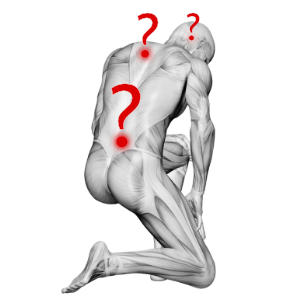Major new content about the trigger point controversy, and my official (fence) position
Working as a massage therapist from 2000–2010, I tried to cure clients’ “trigger points” (aching, sensitive patches of tissue). I wrote a book and many articles about them, all without an inkling that there was any controversy on this topic. I did this even as I was building a strong reputation as a debunker and a writing career based on critical thinking about treatments for pain. And then I discovered that some experts — even some of my own mentors and allies in other debunking battles — had believed for years that trigger point therapy was totally bogus.
Awkward.

The controversy about trigger points has heated up and polarized over the last few years, while I quietly crammed. I studied the conflicting opinions and science, and placed uncertainty disclaimers all over PainScience.com: they may not be what they seem and the science is half-baked and diagnosis is unreliable, and so on. I didn’t pick sides. It’s all “just” a technical argument anyway, a kerfuffle between experts about the explanation for a painful problem. Most patients and professionals are oblivious to the whole mess. I sat on the fence.
Today I’m making my fence-sitting official: I’ve built a little platform up there, because I think it’s a reasonable place to be, and I expect to be camped here for quite a while. I built my perch on the science, such as it is. I’ve written a heavily referenced new article about the central issue: are trigger points explained by something wrong with muscle? I wrote it with the help of Dr. Brian James, formerly a massage therapist and now a physician — and a superb and fair-minded critical thinker with a talent for getting to the heart of the matter. I’m grateful for his assistance.
My personal impression is that Dr. James isn’t really on anyone’s side either: he just wants to understand why people have these painful spots. That’s why I wanted to work with him on this.
And, with that foundation finally laid, I can do this…
The highlights of my current thinking about trigger points and their controversial explanation
- There’s lot of hype and bullshit about trigger points, and way too many professionals now believe in them like religion.
- The trigger point marketing horse is way ahead of the science cart.
- Current methods of trigger point diagnosis & treatment are sketchy at best, quackery at worst.
- Although trigger point science is half-baked, it’s better than many skeptics realize & it fares well in comparison to many other ideas in musculoskeletal medicine.
- The clinical phenomenon commonly known as “trigger points” is all too real, but it remains unexplained.
- I have moderate science-based confidence in the “tiny cramp” theory of how trigger points work.
- The kerfuffle about the popular hypothesis of trigger point formation is a legitimate scientific controversy and it should continue.
- Humble, conservative trigger point therapy is justified, but it should be pitched as “experimental.”
- More painful and reckless trigger point therapies—intense massage, dry needling—are a bad idea.
- The words “trigger point” have a lot of baggage (like chiropractic “spinal subluxation”), but the term is still useful as a label for the symptom, independent of the explanation for it.
- My goal as a writer is to teach people about trigger points … including the controversy. (The phrase “teach the controversy” is odious in the context of creationism, which is a dumb manufactroversy, but I believe it’s apt in the case of trigger points. In fact, that’s my whole point: that we’re not beating a dead horse.)
- When folks Google for “trigger points,” I want them to find my content—including acknowledgement of the controversy, and references to what the skeptics have published.
These points can also now be found near the beginning of my revised and updated “Trigger Point Doubts” article, along with the full story of how my thinking about trigger points and myofascial pain syndrome has evolved over the years. “Once upon a time, I learned about trigger points from my first massage therapy mentor … .”